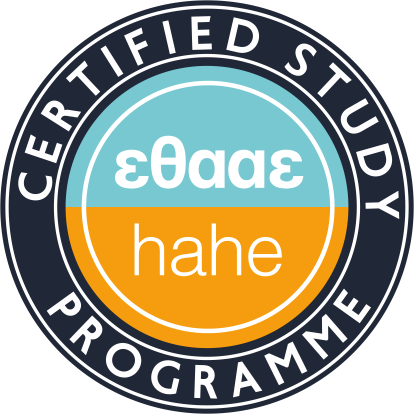Modeling and Management of Business Processes
Teaching Staff: Kourouthanassis Panagiotis
Code: MO170
Course Type: Direction of DTDA - Compulsory
Course Level: Undergraduate
Course Language: Greek
Semester: 6th
ECTS: 5
Teaching Units: 5
Lecture Hours: 4
Lab/Tutorial Hours: 2L
Total Hours: 6
Curricula: Revamped Curriculum in Informatics from 2025
The course Business Process Management and Modeling introduces students to the fundamental principles of Business Process Management (BPM) and process modeling techniques with an emphasis on the BPMN language. Tools and methods for mapping, analyzing, and optimizing business workflows are presented. The course includes an introduction to process simulation for performance evaluation, as well as redesign techniques through digital technologies (BPR). Through case studies and practical applications, students develop skills in designing and improving business processes in real-world environments.
Upon successful completion of the course, students will be able to:
Understand the fundamental principles of Business Process Management (BPM)
-
Explain the importance of BPM for improving efficiency and competitiveness.
-
Distinguish between BPM, BPR (Business Process Reengineering), and Workflow Management.
-
Recognize the role of digital technology in business process management.
Model business processes using BPMN
-
Use the BPMN language for process mapping.
-
Create BPMN models including activities, events, workflows, and decisions.
-
Analyze real business processes and represent them through BPMN diagrams.
Perform business process simulations and analyze their performance
-
Use simulation tools to test and analyze business processes.
-
Evaluate process performance using Key Performance Indicators (KPIs).
-
Apply What-if analysis to compare different scenarios and improve processes.
Propose business process optimization strategies
-
Identify problems in existing processes, such as bottlenecks, delays, and redundant resources.
-
Suggest changes to improve efficiency, quality, and cost-effectiveness.
-
Apply Lean and Six Sigma methodologies to business processes.
Design and implement Business Process Reengineering (BPR) with digital technologies
-
Understand the principles of BPR and differentiate it from continuous process improvement.
-
Propose digital solutions for process automation and reorganization, such as Robotic Process Automation (RPA), Artificial Intelligence (AI) & Machine Learning, Blockchain & smart contracts, ERP & CRM systems.
-
Evaluate the benefits and challenges of BPR using real-world examples.
Develop a complete Business Process Modeling and Simulation Project
-
Design and present a case study of business process modeling and simulation.
-
Use simulation tools to measure performance and identify improvements.
-
Integrate theoretical knowledge with real business problems and solutions.
Week 1: Introduction to Business Processes
-
Definition and importance of business processes
-
Business Process Management (BPM)
-
Relationship between BPM and digital transformation
-
Example analysis of a real business process
Week 2: Business Process Modeling Languages and Approaches
-
Importance of business process modeling
-
Comparison of different modeling approaches
-
Introduction to Business Process Model and Notation (BPMN)
-
Example of a simple BPMN diagram
Week 3: Modeling with BPMN – Basic Elements
-
BPMN symbols and rules
-
Activity diagrams, events, decisions
-
Linking BPMN with real business scenarios
-
Lab exercise with BPMN tools
Week 4: Advanced BPMN Techniques
-
Parallel processes and synchronization
-
Sub-processes and multiple workflows
-
Integrating external systems in BPMN models
-
Case study with real process analysis
Week 5: Introduction to Business Process Simulation
-
Definition and role of simulation
-
Differences between modeling and simulation
-
Types of simulation (discrete event, continuous time)
-
Presentation of simulation tools
Week 6: Performance Analysis through Simulation
-
Business process performance metrics (KPIs)
-
Bottleneck analysis and resource optimization
-
Simulating a BPMN model with data
-
Application in a simulation tool
Week 7: Scenario Analysis and What-if Analysis
-
How simulation supports decision-making
-
What-if analysis: comparing different scenarios
-
Example of alternative workflow comparison
-
Lab exercise with process parameter adjustments
Week 8: Business Process Reengineering (BPR) – Theoretical Background
-
What BPR is and when it is applied
-
Comparing BPM and BPR
-
Core strategies for process redesign
-
Case study of process reorganization
Week 9: Use of Digital Technologies in Redesign
-
Automation and RPA (Robotic Process Automation)
-
Blockchain and smart contracts in business processes
-
Artificial Intelligence & Machine Learning in process improvement
-
Cloud BPM and Software as a Service (SaaS) solutions
Week 10: Transforming Traditional Processes through Technology
-
Examples of successful BPR projects with digital tools
-
Analysis of ERP and CRM use in redesign
-
Designing a “digital twin” of a process
-
Lab exercise on process redesign
Week 11: Case Studies & Best Practices
-
Successful BPR projects and lessons learned
-
Process analysis in industries such as banking, retail, and healthcare
-
Analysis of real BPMN models from enterprises
Week 12: Group Project Discussion – Process Development and Optimization
-
Creation of a BPMN model for a real process
-
Scenario analysis through simulation
-
Proposal for optimization and digital transformation
Week 13: Project Presentations and Conclusions
-
Student project presentations
-
Conclusions on applying BPM, simulation, and BPR
-
Discussion on real-world applications
-
Fitsilis, P. (2018). Modern Enterprise Information Systems ERP-CRM-BPR, 2nd edition, Broken Hill Publishers Ltd. ISBN: 9789925563722
-
Weske, M. (2018). Business Process Management, 2nd Edition, Tziola Publications. ISBN: 9789604187942
Classroom lectures with supporting educational material uploaded on the Open Courses platform
-
Use of business process modeling and simulation software
-
Learning process supported through the e-class platform
Combination of written examinations and submission of a business process modeling and simulation project
Back
Studies
e-mail: cs@ionio.gr




 call for applications 2025-26 (v2)
call for applications 2025-26 (v2)